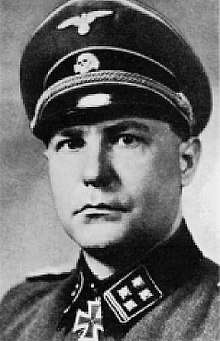Fritz Knoechlein
Fritz Knöchlein (27 May 1911 – 21 January 1949) was an SS commander during the Nazi era who was convicted and executed in 1949 for committing war crimes during World War II, specifically for his responsibility for the Le Paradis massacre.
Fritz Knöchlein | |
|---|---|
 | |
| Born | 27 May 1911 Munich, Kingdom of Bavaria, German Empire |
| Died | 21 January 1949 (aged 37) Hamelin, Lower Saxony, Allied-occupied Germany |
| Allegiance | |
| Service/ | |
| Rank | Obersturmbannführer |
| Service number | NSDAP #157,016 SS #87,881[1] |
| Commands held | SS Division Totenkopf SS Division Reichsführer-SS |
| Battles/wars | World War II |
| Awards | Knight's Cross of the Iron Cross |
Massacre
It was in his capacity as a company commander that he gained notoriety, being responsible for the 27 May 1940 massacre of British prisoners-of-war at Le Paradis in the Pas-de-Calais. Ninety-nine members of the 2nd Battalion of the Royal Norfolk Regiment who had surrendered to his unit in a cattle shed were stood in front of the barn wall, and Knöchlein ordered two machine-guns turned on them, followed by bayoneting and shooting any apparent survivors. Two of the prisoners, privates Albert Pooley and William O'Callaghan, managed to escape the massacre, but the remaining 97 were hastily buried along the barn wall. According to the historians Murray and Millet: "The company commander, Obersturmführer Fritz Knochlein, lined the prisoners up against a barn wall and machinegunned the lot. Any survivors were bayoneted and shot. German military authorities brought no charges against Knochlein."[2]
In 1942, the bodies were exhumed by the French authorities and reburied in a local cemetery which eventually became the Le Paradis War Cemetery.[3] During this time, Albert Pooley made it a personal mission to hunt down Knöchlein and bring him up on charges of war crimes after the war.
Trial and execution
In August 1948, Knöchlein was formally arraigned on charges of war crimes, to which he pleaded not guilty.
- The accused Fritz Knöchlein, a German national, in the charge of the Hamburg Garrison Unit, pursuant to Regulation 4 of the Regulations for the Trial of War Criminals, is charged with committing a war crime in that he in the vicinity of Paradis, Pas-de-Calais, France, on or about 27 May 1940, in violation of the laws and usages of war, was concerned in the killing of about ninety prisoners-of-war, members of The Royal Norfolk Regiment and other British Units.
His trial began on Monday 11 October 1948 in Rotherbaum, and both Albert Pooley and William O'Callaghan were called to testify against him. Knöchlein's defence attorney claimed that Knöchlein had not been present on the day of the battle, and that the British forces had used illegal dumdum bullets during the battle.
Upon being found guilty, Knöchlein applied for clemency, arguing that he had a wife and four children that depended on him. He was sentenced to be hanged, a verdict that was carried out on 21 January 1949.
Awards
- German Cross in Gold on 15 November 1942[4]
- Knight's Cross of the Iron Cross on 16 November 1944[5]
References
Citations
- Westemeier, Jens (2013). Himmlers Krieger: Joachim Peiper und die Waffen-SS in Krieg und Nachkriegszeit [Himmler's Warriors: Joachim Peiper and the Waffen-SS during the War and Post-War Period]. Paderborn, Germany: Ferdinand Schöningh. p. 662. ISBN 978-3-506-77241-1.CS1 maint: ref=harv (link)
- Murray & Millett 2000, p. 90.
- "Le Paradis War Cemetery, Lestrem." Commonwealth War Graves Commission. Retrieved 7 November 2015
- Patzwall, Klaus D.; Scherzer, Veit (2001). Das Deutsche Kreuz 1941 – 1945 Geschichte und Inhaber Band II [The German Cross 1941 – 1945 History and Recipients Volume 2] (in German). Norderstedt, Germany: Verlag Klaus D. Patzwall. p. 238. ISBN 978-3-931533-45-8.CS1 maint: ref=harv (link)
- Scherzer, Veit (2007). Die Ritterkreuzträger 1939–1945 Die Inhaber des Ritterkreuzes des Eisernen Kreuzes 1939 von Heer, Luftwaffe, Kriegsmarine, Waffen-SS, Volkssturm sowie mit Deutschland verbündeter Streitkräfte nach den Unterlagen des Bundesarchives [The Knight's Cross Bearers 1939–1945 The Holders of the Knight's Cross of the Iron Cross 1939 by Army, Air Force, Navy, Waffen-SS, Volkssturm and Allied Forces with Germany According to the Documents of the Federal Archives] (in German). Jena, Germany: Scherzers Militaer-Verlag. p. 454. ISBN 978-3-938845-17-2.CS1 maint: ref=harv (link)
Bibliography
- Murray, Williamson; Millett, Allan R. (2000). A War To Be Won: Fighting the Second World War (3rd ed.). Cambridge, Mass.: Belknap Press of Harvard University Press. ISBN 978-0-674-04130-1. Retrieved 7 November 2015 – via books.google.com.au.CS1 maint: ref=harv (link)